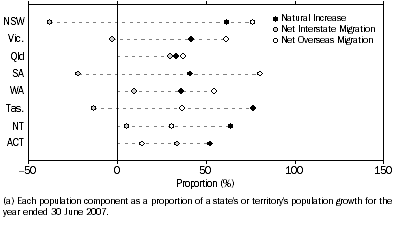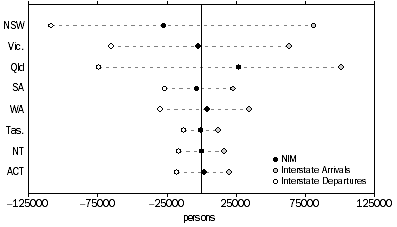MAIN FEATURES
AUSTRALIA: POPULATION AND GROWTH
The preliminary estimated resident population (ERP) of Australia at 30 June 2007 was 21,017,200 persons, an increase of 315,700 since 30 June 2006 and 68,300 persons since 31 March 2007. The increase for the year ended 30 June 2007 is the highest recorded for a 12 month period since the ERP concept was introduced in 1971 (see paragraphs 4 to 6 of the Explanatory Notes for more detail).
The annual population growth rate for the year ended 30 June 2007 at 1.53% was the highest annual growth rate for a year ended 30 June since 1989.
PRELIMINARY DATA
Due to the collection and estimation methods applied to produce preliminary statistics from the components of population change, users should exercise caution when analysing and interpreting the most recent quarterly estimates.
COMPONENTS OF POPULATION CHANGE
Natural Increase
The growth of Australia's population has two components: natural increase (the number of births minus the number of deaths) and net overseas migration (net permanent and long-term movement).
Natural increase for the 12 months ended 30 June 2007 was 138,100 persons, an increase of 6.7% (or 8,700 persons) on the natural increase for the year ended 30 June 2006 (129,400 persons).
BIRTHS
The preliminary estimate for births (272,900) during the year ended 30 June 2007 was 3.6% higher than the figure for the year ended 30 June 2006 (263,400). Births in the year ended 30 June 2007 was the highest ever recorded for years ending 30 June.
The total fertility rate (TFR) for the year ended 30 June 2007 was 1.853 which is the highest recorded since the year ended 30 June 1993.
DEATHS
The preliminary estimate for deaths during the year ended 30 June 2007 (134,800) was the highest ever recorded for a year ending 30 June.
The standardised death rate (SDR) for the year ended 30 June 2007 was 5.93 which is the lowest ever recorded. The infant mortality rate (IMR) for the year ended 30 June 2007 was 4.62 which is also the lowest ever recorded.
Net Overseas Migration
For the year ended 30 June 2007, Australia recorded a preliminary net overseas migration (NOM) estimate of 177,600 persons. This increase accounted for 56% of the total population increase in the year ended 30 June 2007.
AN IMPROVED METHOD FOR CALCULATING NOM
The ABS has introduced an improved method for estimating NOM. This method has been used for September quarter 2006 onwards. Preliminary NOM estimates are based on international movement data for the reference quarter, adjusted by information derived from travellers with the same characteristics from the corresponding quarter two years earlier. Final NOM estimates for the four quarters of 2006-07 (scheduled for release in March 2009) will be based on the actual duration of stay in Australia and overseas of international travellers.
The time series using the previous method for calculating NOM finishes at June quarter 2006. Estimates from this past time series and the current time series are not comparable. For further information see Information Paper: Improved Methods for Estimating Net Overseas Migration (cat. no. 3107.0.55.003); Information Paper: Statistical Implications of Improved Methods for Estimating Net Overseas Migration, Australia 2007 (cat. no. 3107.0.55.005); and the Technical Note Measuring Net Overseas Migration, Method Used September Quarter 2001 to June Quarter 2006 in the March quarter 2007 issue of this publication (cat. no. 3101.0).
STATES AND TERRITORIES: POPULATION AND GROWTH
The estimated resident populations for the states and territories at 30 June 2007 were as follows: New South Wales 6,889,000, Victoria 5,205,000, Queensland 4,182,000, South Australia 1,585,000, Western Australia 2,106,000, Tasmania 493,300, the Northern Territory 215,000, and the Australian Capital Territory 339,900. All states and territories recorded positive population growth over the 12 months ended 30 June 2007. Western Australia recorded the fastest growth rate (2.3%), followed by Queensland (2.2%), the Northern Territory (2.0%), the Australian Capital Territory (1.7%), Victoria (1.5%), New South Wales (1.1%), South Australia (1.0%) and Tasmania (0.7%).
COMPONENTS OF POPULATION CHANGE
At the state and territory level, population growth has three components: natural increase, net overseas migration and net interstate migration.
Although all states and territories experienced positive population growth in the year ended 30 June 2007, the proportion that each of these components contributed to population growth varied between the states and territories.
Population Components, Proportion of total growth(a)
- Year ended 30 June 2007

Natural Increase
As illustrated in the graph above, natural increase was the major component of population growth in Tasmania at 76.6% (2,600 persons), the Northern Territory at 64.0% (2,800 persons) and the Australian Capital Territory at 52.3% (2,900 persons) for the year ended 30 June 2007.
BIRTHS
The number of births registered for the 12 months ended 30 June 2007 showed an increase in births registrations in all states, with Western Australia recording the largest increase of 6.3%.
DEATHS
Deaths registered for the year ended 30 June 2007 showed South Australia and New South Wales both experienced annual decreases of 1.2% and 0.4% respectively. All other states and territories recorded an increase in death registrations, with Victoria recording the largest increase of 2.6%.
Net Overseas Migration
Net overseas migration for the year ended 30 June 2007, as illustrated in the previous graph, was the major component of population growth in South Australia at 80.6% (13,100 persons), New South Wales at 76.4% (54,900 persons), Victoria at 61.3% (47,200 persons), Western Australia at 54.6% ( 25,500 persons) and Queensland at 37.0% (33,500 persons). All other states and territories experienced positive NOM.
Net Interstate Migration
Estimates of quarterly interstate migration showed there were 351,900 persons moving interstate within Australia for the year ended 30 June 2007. Queensland, the Australian Capital Territory and Western Australia recorded larger increases from net interstate migration when compared to the previous year ended 30 June. New South Wales, South Australia, Victoria and Tasmania experienced a larger loss from net interstate migration. Over the same period, the Northern Territory changed from negative to positive net interstate migration.
INTERSTATE MIGRATION, Arrivals, Departures and Net
- States and territories
- Year ended 30 June 2007

As illustrated in the graph above, Queensland experienced the highest positive net interstate migration with a gain of 27,000 persons for the year ended 30 June 2007. Other states and territories to experience a positive net interstate migration were Western Australia (4,400 persons) the Australian Capital Territory (1,900 persons) and the Northern Territory (230 persons). Negative net interstate migration was experienced by New South Wales (27,300 persons), South Australia (3,600 persons), Victoria (2,200 persons) and Tasmania (450 persons).
INTERNATIONAL COMPARISON
For the 12 months ended 30 June 2007, Australia's population growth rate (1.5%) was higher than that of the world (1.2%). Australia's growth rate was lower than that of Papua New Guinea (2.2%), Malaysia (1.8%), and India (1.6%). It was higher than Singapore (1.4%), Indonesia (1.2%), New Zealand (1.0%), Canada (0.9%), United States of America (0.9%), Thailand (0.7%), China (0.6%), Hong Kong (0.6%) and the United Kingdom (0.3%). Unlike Australia, Germany experienced no change. Further, Japan experienced a decrease in population (0.1%).
According to figures from the US Bureau of Census' International Data Bank of 224 countries, Australia's population size ranked 54th in 2007 (no change from 2006) and is projected to rank 65th in 2050. By 2050, India is projected to have displaced China to become the most populous country with close to one fifth of the world's population at 1.8 billion people.
Population, growth rate and rank, Selected countries - at 30 June |
|  |
 | Estimated population | Projected population | Rank |  |
 | 2006 | 2007 | Growth Rate | 2050 | 2007 | 2050 |  |
| Country | million | million | % | million | no. | no. |  |
|  |
| Australia | 20.7 | 21.0 | 1.5 | 24.2 | 54 | 65 |  |
| Canada | 33.1 | 33.4 | 0.9 | 41.4 | 36 | 44 |  |
| China | 1 314.0 | 1 321.9 | 0.6 | 1 424.2 | 1 | 2 |  |
| Germany | 82.4 | 82.4 | 0.0 | 73.6 | 14 | 22 |  |
| Hong Kong (SAR of China) | 6.9 | 7.0 | 0.6 | 6.2 | 98 | 117 |  |
| India | 1 111.7 | 1 129.9 | 1.6 | 1 807.9 | 2 | 1 |  |
| Indonesia | 231.8 | 234.7 | 1.2 | 313.0 | 4 | 5 |  |
| Japan | 127.5 | 127.4 | -0.1 | 93.7 | 10 | 17 |  |
| Malaysia | 24.4 | 24.8 | 1.8 | 43.1 | 46 | 42 |  |
| New Zealand | 4.1 | 4.1 | 1.0 | 4.8 | 124 | 126 |  |
| Papua New Guinea | 5.7 | 5.8 | 2.2 | 10.7 | 106 | 92 |  |
| Singapore | 4.5 | 4.6 | 1.4 | 4.6 | 117 | 130 |  |
| Thailand | 64.6 | 65.1 | 0.7 | 69.3 | 20 | 25 |  |
| United Kingdom | 60.6 | 60.8 | 0.3 | 64.0 | 22 | 29 |  |
| United States of America | 298.4 | 301.1 | 0.9 | 420.1 | 3 | 3 |  |
| World | 6 525.6 | 6 602.3 | 1.2 | 9 401.6 | . . | . . |  |
|  |
| . . not applicable |
| ABS for Australian estimates and projected populations (Series B); US Bureau of Census, International Data Base (IDB) for selected countries and world estimated and projected populations and all rankings. |
 Print Page
Print Page
 Print All
Print All